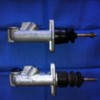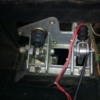I just got done with replacing a stock clutch master which has a 0.75 inch bore with a Wilwood clutch master 0.625 bore. I also replaced the clutch slave as well that I got from Mangusta International. The job took a good 5 hours with two people. Its probably would be very difficult to do with only one person as to remove the bolts to the clutch master requires someone holding the bolt from the trunk of the firewall and another to unscrew the nut or bolt from under the dash. Main reason for switching was to reduce the pedal pressure. After filling the system with silicone brake fluid I felt the clutch action to be smoother and clutch effort reduced by about 15%. The two master cylinders were almost identical in size and configuration. The original is Girling and the new one is one I got from Summit racing (Wilwood). Some notes on the job. You need to be able to hang upside down for at least an hour. You will need an crowfoot open end wrench of 5/8 size. You need to be careful not to wiggle the feed line from the main reservoir to the clutch master as the old rubber seal at the base of the reservoir may be damaged and start leaking. I had to replace mine after finding the seal on the base of the reservoir was old and did not make a good seal with the brass line. I could not find another seal so I cut a small section of 1/4 inch fuel line and it fit well. Finally you need to be skinny because it is tight quarters under the dash. I hope that help some people. Ben
Attachments
Original Post



